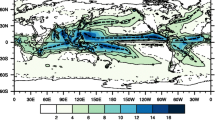Summary
The monsoon is a global climate phenomenon. This paper addresses the seasonal reversal of atmospheric circulation and the transition of dry/wet spells in the monsoon regions worldwide. The NCEP/NCAR 850 hPa wind reanalysis data for 1950–1999 and the upper-tropospheric water vapour (UTWV) band brightness temperature (BT) data observed by NOAA polar orbiting satellites for 1980–1995 are used. In the tropics, there are three large wet-UTWV centres. The summer monsoon in the subtropics can be defined as the expansion of these centres associated with the influence of cross-equatorial flows. Specifically, the dry/wet spell transition is determined by the BT values that are smaller than 244 K. The regions of the South and North African monsoons, the Asian-northwest Pacific and Australian-Southwest Pacific monsoons, and the North and South American monsoons are examined with a focus on the dry/wet spell transition and stream field features.
Findings suggest that the summer monsoons over many subtropical regions can be defined by both cross-equatorial flows and dry/wet spell transitions. In the mid- and low-latitudes, there exist six major dry/wet spell transition regions with a dry or wet period lasting more than one month. The region of most significant change is located over the subtropical North Africa–Asia–northwest Pacific. The others appear over subtropical South Africa, Indonesia–Australia, southwest Pacific, the Mexico-Caribbean Sea, and subtropical South America. In addition, three regions exist where only one of the two indicators (cross-equatorial flow and dry/wet transition) is satisfied. The first is near the Equator where the directions of cross-equatorial flows alternate but a dry/wet spell transition is never experienced. The second is over North Africa where only the dry/wet spell transition can be found but not the cross-equatorial flows. The third is over the mid-latitude regions in North China, South Africa, and northern North America. These regions are influenced by cross-equatorial flows but the upper-tropospheric water vapour content is not as high as that in tropical regions.
Similar content being viewed by others
Author information
Authors and Affiliations
Additional information
Received June 29, 2000 Revised May 15, 2001
Rights and permissions
About this article
Cite this article
Qian, W., Deng, Y., Zhu, Y. et al. Demarcating the worldwide monsoon. Theor Appl Climatol 71, 1–16 (2002). https://doi.org/10.1007/s704-002-8204-0
Issue Date:
DOI: https://doi.org/10.1007/s704-002-8204-0




